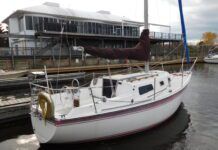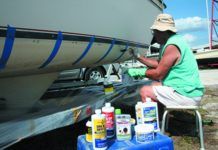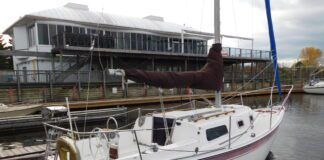Battery Isolation
The March 2001 Gear Survey article discussed an electronic battery isolator. I had a similar problem with a three-battery system with a diode isolator for the alternator and a four-position switch for the house batteries and an on/off switch for the engine battery.
After having starting problems, I tied the two house batteries in parallel at the number one pole of the four-position switch and put the engine battery on the number two pole of the switch. I then fed a wire from the output of the house switch to the engine switch. Now I could use one, two, or three batteries to start if necessary.
In addition, I added a jumper tying all three batteries in parallel across a solenoid that closed when voltage from the alternator was present at the input to the isolator, i.e. when the motor was running. This gave each battery a uniform charge that I was not sure I was getting before. Voltage drop across the isolator never seemed to be a problem since the output from the isolator would approach 14.4 volts.
The solenoid was far less costly then the electronic isolator. The only manual switch selection that was necessary was to make certain that the number one switch was on if the engine was not running. It turned out that most of the time the engine was started in that position.
-Albert L. Chasson
Raleigh, North Carolina
Star-Brite Tropical Oil Sealer
I read with interest the test/evaluation of teak finishes in the March 2001 issue. I was surprised you did not mention the Star-Brite Tropical Oil/Sealer. I started using it five years ago on my Catalina, which has oodles of teak trim, pads, rails, etc. This product requires only a light cleaning and when applied as instructed with a foam brush does not drip or spatter. It dries to touch in a few hours; weather boards can be reinstalled the same day with a sheet of Saran Wrap inserted between the boards. No clean-up is required as there is no drip or spatter. Brushes are discarded.
I find the color attractive and it lasts 18-24 months in continuous outdoor exposure. I have since thrown away all the cleaners, bleaches, oils, bristle brushes, thinners, vinyl gloves, stirring paddles, wiping rags, scrub brushes and brush cleaners required for traditional teak finishes.
-Richard Rhodes
North Plainfield, New Jersey
(Editors Note: In the March article we limited ourselves to traditional varnishes, with teak wood serving as the test panel material. Your letter is a good reminder of why wed spent the previous several tests on treatment/sealers.)
Bottom Paint
Thank you very much for your review and test of bottom paint. This is a great example of the value of your service. Probably from sheer luck I have been using two of your high-rated products in recent years-Micron CSC Extra (blue) and Trinidad SR (black). I have had both sail and power and in the rapid-fouling waters of Tampa, FL, I personally have found the Trinidad SR a bit better at keeping slime down. Both do an excellent job on barnacles. And both are great products.
A note to your readers-they still sell the Trinidad (without the SR), so be careful to purchase the SR version of the paint, apparently with additional additives to reduce slime. Both Micron and Trinidad are easy to apply (we do it ourselves), however the edge probably goes to Trinidad because of the drying time on the Micron. Long term, the Micron does not build up like the Trinidad does, since the Micron is ablative.
With either paint, we still need a diver about once a month to wipe down the hull-but mostly to clean the prop and running gear. Has anyone figured out a way to keep the prop clean over a season? A friend copper-plated his prop and that didn’t work. A recent letter in Practical Sailor described why-apparently the zincs keep the oxidation down and reduce the effectiveness of the copper. If anyone has a good solution, please let me know.
-M. Cain
Via e-mail
(Editors Note: Weve had several letters with questions about the exact versions of Interlux bottom paints we tested versus whats on the market. Heres a brief rundown:
Interlux used to make a paint called “Micron CSC Extra,” but no longer. Stock of that paint, however, is still carried by West Marine at a price of around $130 per gallon on their website. It’s not listed in their 2001 catalog. This was the paint we began testing a year ago for inclusion in the March 2001 article you’ve seen. It included Biolux, an anti-slime agent (that was the extra part). The name of that paint today is Micron Extra with Biolux. Its listed on West Marine’s website for $155 and in their 2001 catalog for $170. Finally, Interlux still makes its old standby, “Micron CSC,” which doesn’t contain Biolux. That paint is not currently listed on West Marine’s website, but is listed in their catalog for $150 per gallon.
Abandon-ship Bags
I don’t get it. Why do you want to take 42 pounds of dumbbells into your life raft?
My bag holds a few pairs of polypropylene long underwear, some space blankets, a handheld VHF, some duct tape (first aid for man and raft), flashlight and extra batteries, water, cups, medical kit, etc, etc. The total weight is under 35 pounds. All items are separately packed in ZipLoc bags to give added buoyancy and wet-proofing, but I don’t really expect anything to stay dry for very long in an abandon-ship situation.
-Louis Meyer
Via e-mail
(Editors Note: Sure, the new offshore regs call for 10.5 lbs. of iron per person, so we loaded the bags for a crew of 4. Seriously, it sounds as if you’ve given good thought to your abandon-ship bag. Thanks for the notes.)
Express 34 Praise
Its about time that the Express 34 (April 1 , 2001) gets some respect! We bought ours (hull #26) new in 1989 after the company had folded. It came with a 10-year blistering warranty, which of course was useless without the builders, but we never had a problem anyway. In fact we never had any problems with her; she was just so well built! She came with rod rigging, which I thought was standard, not wire as you said. She weighed 8000 lbs., the same as our present J/105, but with far, far more amenities and room. We raced her for 10 years almost year round and she looked brand new when we sold her. I miss her a lot, especially when I compare her construction to the J/105. No wonder the company went bankrupt; we heard that the boats were costing at least 10% more to build than they were selling them for. The quality was just superb. There is no headliner; the interior of the hull is finished so it is easy to mount hardware, find leaks (almost none anyway), etc. I wish all boats were built likethat!
Thanks for a great article. We raced our Express against Hobie 33s , Olson 29s and 30s , and a Soverel 33. We always shone in higher wind and seas, on lighter days they were faster but we did well anyway!
-Jane Francoeur
Naples, Florida
Speedtech Response
I understand your problem with the Skywatch Elite windmeter (March, 2001) It was first brought to Speedtech’s attention about a year ago that the spindle, on which the impeller is mounted, was not constructed using stainless steel. Over that one-year duration, Speedtech worked closely with the manufacturer to make a more suitable spindle that could withstand the saltwater environment and still maintain the same cost. During the development period, Speedtech did not stock the Elite, in anticipation of the upgraded model.
As mentioned in your review, your replacement came with a sticker, warning against the use of your windmeter in the saltwater environment. Unfortunately, the unit you purchased at West Marine was from older stock, not displaying the stickers.
Please note: the older units can be used in the saltwater environment, but need daily rinsing with fresh water and need to be taken down when not in use, as do most instruments of this kind. The new units, however; operate without problems in all environments, but will still require some degree of care and maintenance. In both cases, the instrument should be dried off after considerable water exposure. The new units, in my own experience, are much improved.
-Scott Avery
Speedtech Instruments
Keel Bolt Replacement
I own an Elite 324, which is a French production boat, and I have had to replace a few of the keel bolts. The keel on this boat is cast iron and the bolt is actually a 16-mm threaded rod tapped into the keel with a nut and heavy backing plate on top. This certainly makes replacement easier than the method described in the April, 2001 Mailport, but certainly requires monitoring of the bolt tightness. In talking with a friend who owned a Beneteau, it appears that they use the same method of keel attachment and recommend replacement every 8-10 years.
-Eddy Parker
Raleigh, North Carolina
Stereos Revisited
I was reading your test of stereos/radios in the April 1, 2001 issue and decided that the real subject is “home stereo sound on the water.” Car and marine units don’t differ very much and are not as satisfying as what you hear at home.
About five years ago we were looking to equip our 1968 Bristol 29 with a decent music system. I told the manager at Cambridge Soundworks in Peabody, Massachusetts about our needs and he took us over to see the “Soundworks,” which is a powered subwoofer (120 volts for home and/or 12 volts for car or boat, plugging into a cigarette lighter) with two small satellite speakers which can be placed anywhere. Plug any Walkman or Discman into this unit for home-style sound. You can buy a carry bag for the speaker set-up, so it’s easily portable any time you want to take it with you. I believe this is one of the best systems you could ever want in a boat. It’s a great sound for a mere $75.
-Bill Kearney
Peabody, Massachusetts
On my boat, I play CDs through a portable CD player connected to a stand-alone amplifier. It looks like hell, is wired awkwardly, and is a pain to operate. But it does one thing that I can’t get from any marine CD player: It stops at the end of the recording.I called one manufacturer to ask about this, and the tech on the other end of the phone said, No, theres no way you can keep it from repeating. All car stereos operate that way. (I hadnt thought I was calling about a car stereo.)
The techs observation may be valid for a small day boat, where the stereo is in the console and never very far from the driver. But on a cruising boat, when youre playing yourself to sleep at night, its just outright painful to wake up at three oclock in the morning with that gorgeous, soothing song drilling its annoying way into your skull. Not to mention when it spins back around to Track 1 of the album you started on Track 2 because you hate Track 1, and youre up top executing maneuvers and can’t break away to stop it, but now Im getting into pet peeves…
Couldnt the manufacturers of marine stereos just give us a repeat button and let us choose? How hard could it be?
-Doug Hoople
Sausalito, CA





































